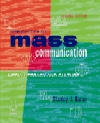 |
1 |  | 
Middle-range theories are |
|  | A) | explanations and predictions of social phenomena that attempt to relate mass communication to various aspects of our personal and cultural lives or social systems. |
|  | B) | ideas that explain or predict only limited aspects of the mass communication process. |
|  | C) | theories that explain media's influence over middle-class or typical people. |
|  | D) | attempts to mediate between competing paradigms. |
 |
 |
2 |  | 
A paradigm is |
|  | A) | a theory that summarizes and is consistent with all known facts. |
|  | B) | an explanation of social phenomena that attempts to relate mass communication to various aspects of our personal and cultural lives or social systems. |
|  | C) | an idea that explains or predicts only limited aspects of the mass communication process. |
|  | D) | another name for grand social theory. |
 |
 |
3 |  | 
The Orson Wells radio production of The War of the Worlds began the era of _______ in the development of mass communication theory. |
|  | A) | mass society theory |
|  | B) | cultural theory |
|  | C) | limited effects theory |
|  | D) | the scientific perspective on mass communication theory |
 |
 |
4 |  | 
In studying how media's influence is affected by people's intelligence and education, individual differences theory is an example of the era of |
|  | A) | mass society theory. |
|  | B) | cultural theory. |
|  | C) | limited effects. |
|  | D) | the scientific perspective on mass communication theory. |
 |
 |
5 |  | 
In two-step flow theory, media influence passes from ___________ to opinion followers. |
|  | A) | the media |
|  | B) | opinion leaders |
|  | C) | powerful elites |
|  | D) | opinion makers |
 |
 |
6 |  | 
Uses and gratifications theory argues that |
|  | A) | media don't do things to people, rather, people do things with media. |
|  | B) | media producers can dictate the uses to which people put media. |
|  | C) | only selected, especially well-crafted, media messages can influence gratifications. |
|  | D) | people use media to gratify only unimportant needs, such as keeping up on fashions. |
 |
 |
7 |  | 
Klapper's reinforcement theory argues that |
|  | A) | media are quite powerful, especially in the realm of reinforcement. |
|  | B) | only selected, especially well-crafted, media messages can influence reinforcement. |
|  | C) | media have little power, but what influence they do have is in the form of reinforcement. |
|  | D) | mediating variables make media powerful agents of change. |
 |
 |
8 |  | 
Agenda-setting is a theory that argues that |
|  | A) | reality is a social construction. |
|  | B) | cultures attribute meaning to symbols which then control behavior. |
|  | C) | media do not tell us what to think, but what to think about. |
|  | D) | children can learn violence through watching television. |
 |
 |
9 |  | 
Dependency theory argues that |
|  | A) | people learn to model the behaviors they see through observation. |
|  | B) | audience members don't just passively take in and store bits of information, they actively process this information, reshape it, and store it. |
|  | C) | media's influence resides in the relationship between the larger social system, the media's role in that system, and audience relationships to the media. |
|  | D) | people who share a culture also share an "ongoing correspondence" of meaning. |
 |
 |
10 |  | 
According to ______________, television constructs a reality of the world that, although possibly inaccurate, becomes accepted simply because we as a culture believe it to be true. |
|  | A) | critical cultural theory |
|  | B) | the Frankfurt School |
|  | C) | cultivation analysis |
|  | D) | social construction of reality theory |
 |



 2002 McGraw-Hill Higher Education
2002 McGraw-Hill Higher Education